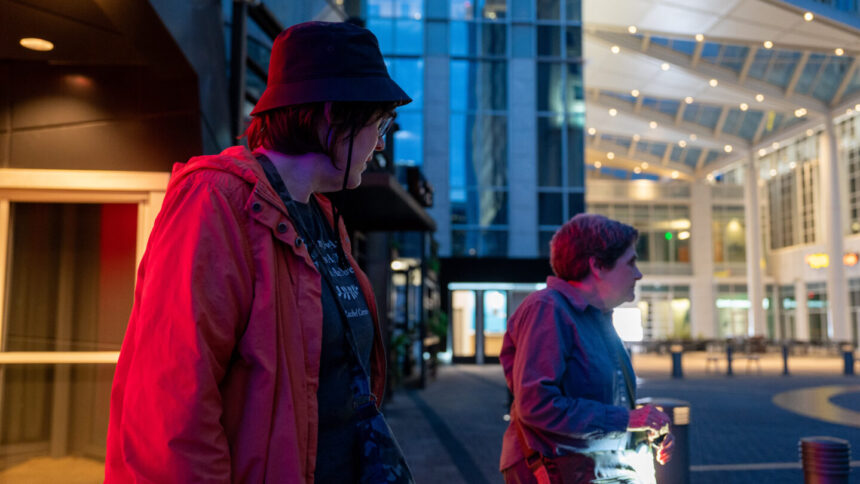“About 990,000 passed last night over Fulton County,” Osborne said.
But the city lights draw the migrating birds in, and Osborne says that the confusion can cause birds to strike windows.
Her and Bryan stick close to the edges of the buildings, looking for stunned or dead birds that have fallen to the ground. They start their work early in the morning to beat cleaning crews and scavengers that might pick up the birds before them.
“I still get shocked every time I see one,” Osborne said. “I love birds, and this is just one way you feel like maybe you can help a little bit.”
Bryan has been volunteering for a bit longer. She said that in her time perusing around for dead birds in the morning, she’s made lots of friends —people who ask her what she’s doing and are interested in learning more about birds.
But not every interaction goes that well.
“Now listen, they put that gate up here because of me,” Bryan said.
Some security guards are less than enthused to have ladies with flashlights skulking around their buildings in the pre-morning dawn, nevertheless, routinely.
The volunteers and Birds Georgia use it as an opportunity to educate staff and buildings about the bird collision problem.
“It’s like the worst lesson in birds,” Bryan said.
And for Osborne, it’s a harsh perspective at the scale of the problem.
“I still get shocked every time I see one,” she said.
Karen Osborne uses a flashlight to look for stunned or dead birds at the bottom of glass windowed buildings. (Matthew Pearson/WABE News)
But this morning was a good one. By the time light was breaking over the skyscrapers, Osborne and Bryan hadn’t found any birds.
It doesn’t mean there definitely weren’t any picked up before they arrived, nor does it mean there won’t be any bird collisions soon, but in the meantime, they take the win.
If they find a stunned bird, Bryan said they’re trained to transport it to a local rehabber. If the bird is dead, they pass it along to researchers.
Adam Betuel, the Director of Conservation at Birds Georgia, said that after collecting data from the dead birds, they send the specimens to research universities.
“We’ve sent birds to UGA, Oglethorpe, even Colorado State Puebla,” Betuel said. “But most of them go to the University of North Georgia.”
The director said the specimens are used for everything from ornithology teaching labs to museum collections to genome research. The data that volunteers collect can be leveraged to educate people on the problem.
Overall, Betuel said the program has collected nearly 5,000 individuals of over 130 species.
The scale of the problem is a lot larger than most people might think, Betuel said.
“According to the best estimates, 350 million to 1 billion birds a year in the U.S. alone are dying from running into buildings, which is behind only habitat loss and outdoor cats,” Betuel said.

Morning light reflects off windows in Buckhead. (Matthew Pearson/WABE News)
Most of the birds coming through Atlanta are neotropical — meaning they’ve made thousand-mile journeys across various countries and the Gulf.
The city is at the convergence of three major migratory routes. It also has great resources like the Chattahoochee that attract the birds.
“All this stuff, and then they just run into a building — it’s so pointless,” Betuel said.
Birds can hit windows at any time of year, but it’s especially worse during migration. Betuel said a lot of folks don’t realize that birds migrate at night, and light pollution and ambient light confuse the birds. It’s like a moth and a porch light, he said.
Once the birds are drawn into the city, the glass creates a maze of mirrors.

Reflections off a glassy building. (Matthew Pearson/WABE News)
“Birds often don’t understand that a transparent barrier, or a transparent facade, is a barrier,” Betuel said.
The birds will attempt to fly through the glass full force. Otherwise, he said landscapes like trees would reflect in glass and look to birds like a good place to fly toward or perch, causing them to smash at high speed into the glass.
The good news, he said, is that solutions already exist. For existing buildings, there’s a host of products that adhere to the outside of windows and enable the birds to see that the windows aren’t permeable surfaces.
But for buildings not yet built, Betuel said there’s even better, sleeker options. There are windows, like the ones at Birds Georgia’s new office building in Adair Park, that look like regular windows but have tiny dots between the panes of glass for birds to see.
Not only do they appear sleeker, he said, but research has said these windows are highly effective in preventing bird collisions.
“There are some very sleek, minimalistic approaches where you can still get all your natural light, you’ll still have your views, and you also won’t have dead or injured birds below the windows,” Betuel said.
These solutions are for any type of building. While skyscrapers seem like they’d hit birds more often up in the sky, Betuel said the “overwhelming majority” of collisions happen in the bottom 40 to 50 feet on a building where vegetation is reflected.
He said Birds Georgia also encourages residences and commercial properties to use smarter lighting at night—for example, having lights down-shielded—especially during migration season.
Several buildings around the metro area are working on these solutions.
But upgrading the city one building at a time is tedious and slow, Betuel said.
He added that while looking toward scaling up the solution, Birds Georgia is pursuing bird-friendly glass solutions in construction and ordinances or legislation to include bird-safe glass in the design process.











